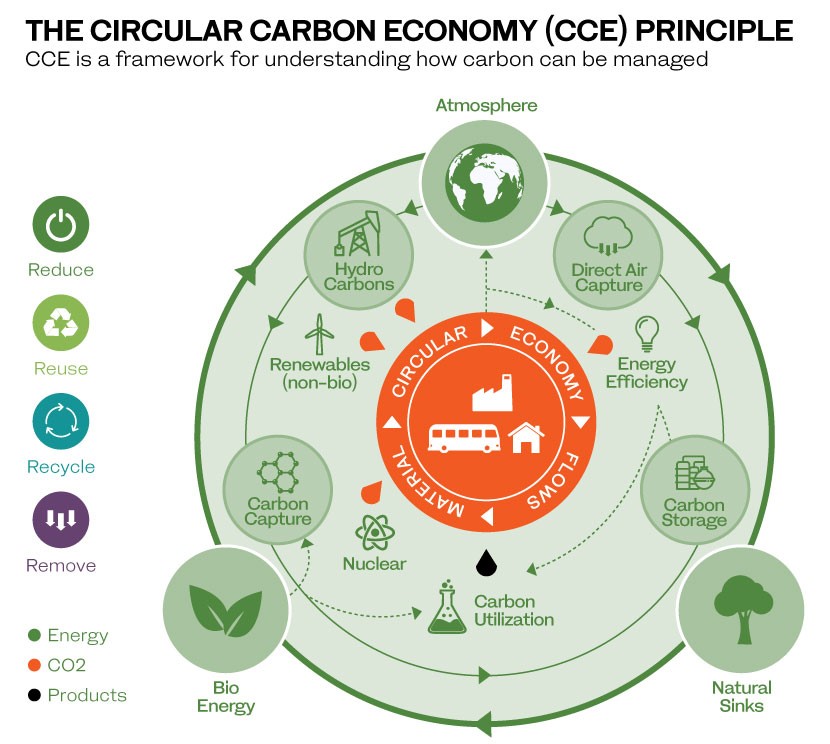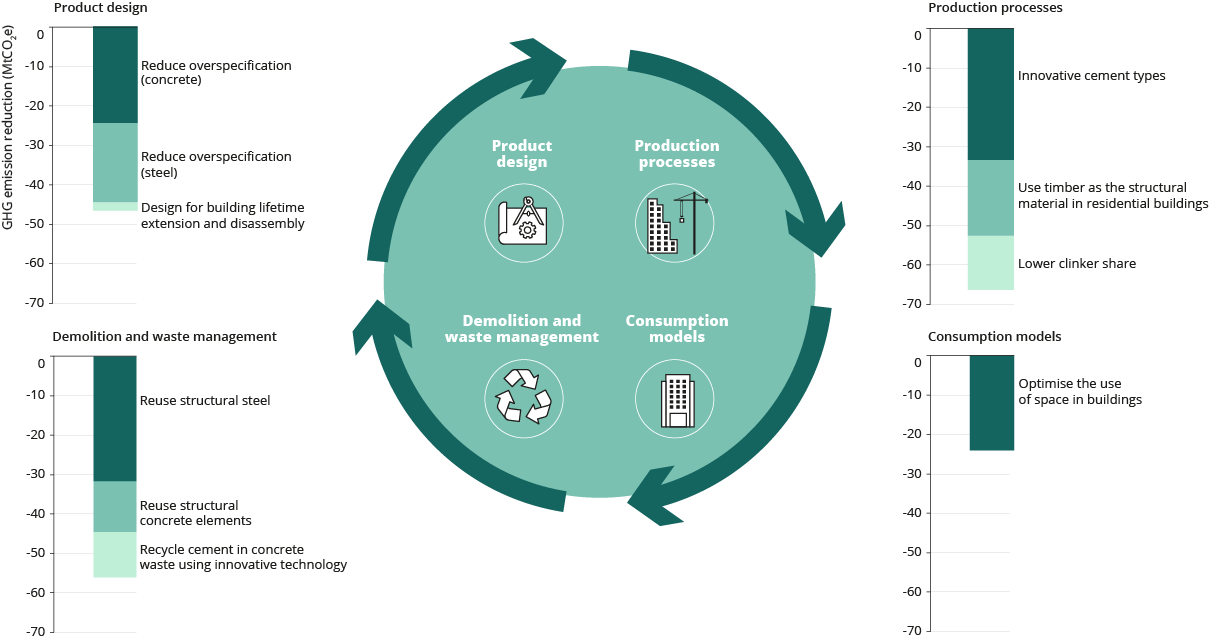Introduction
In an era of heightened awareness about climate change, global governments, and businesses are increasingly recognizing the urgency to reduce and offset carbon emissions. With a shared commitment to achieving net zero emissions by 2050 as per the Paris Climate Agreement, it becomes crucial to explore effective strategies for reaching this ambitious goal.
This article will delve into the concept of the circular carbon economy (CCE) and its pivotal role in capturing and repurposing carbon dioxide (CO2) emissions, thereby mitigating climate change and supporting global sustainability initiatives.
Understanding the Circular Carbon Economy
The circular carbon economy marks a groundbreaking paradigm shift in our approach to carbon emissions. It revolutionizes the perception of what was once considered industrial waste, transforming it into a valuable resource that can greatly reduce the environmental impact of carbon emissions.
Through the utilization of carbon capture, utilization, and storage (CCUS) technologies, this innovative approach enables the captured carbon to be repurposed in the production of fuels, plastics, and various other products, creating a circular and sustainable system.

Figure 1 (Source: KAPSARC)
This emerging green economy has the potential to revolutionize the way businesses perceive and utilize carbon. Instead of viewing it as a liability and a harmful pollutant, forward-thinking companies now have the opportunity to harness carbon as a valuable asset. By capturing and reusing carbon, these businesses can not only reduce their carbon footprint but also contribute to the development of a more sustainable future.
However, despite the immense potential of the circular carbon economy, the alarming reality remains that a staggering 40 billion tonnes of carbon is released into the atmosphere each year in the form of carbon dioxide (CO2). This massive volume of emissions poses a significant challenge to achieving global climate goals and urgently calls for effective solutions to mitigate the adverse effects of climate change.
Reducing Greenhouse Gas Emissions through the Circular Carbon Economy
To achieve the goal of net zero emissions by 2050, industrial CO2 emissions must be reduced by approximately 45% by 2030 alone, in line with the Paris Agreement. The circular carbon economy offers a substantial contribution to this target, with the potential to eliminate nearly half of the remaining greenhouse gas emissions.
By capturing and reusing an estimated 9.3 billion metric tonnes of CO2 by 2050, industries can significantly reduce their environmental footprint. This necessitates the immediate implementation of carbon capture solutions on a large scale, allowing businesses to align with the 2030 and 2050 targets.
Net Zero and the Role of Heavy Industry
The concept of net zero revolves around minimizing human-induced carbon emissions into the Earth's atmosphere, with any remaining emissions offset through carbon removal techniques.
Implementation of essential measures can yield a reduction in emissions of up to 61% throughout the life cycles of buildings.
The selection of the buildings sector as a focus area stems from its crucial role in attaining long-term climate neutrality, given the lasting impact of emissions associated with buildings. The European Green Deal's circular economy action plan, within the EU, reinforced the significance of enhancing circularity in the construction and buildings sector to reduce waste, improve material utilization, and further decrease greenhouse gas emissions (EC, 2020).
This approach emphasizes that every stage of a building's life cycle, spanning from design and production to consumption, demolition, and waste management, presents valuable opportunities for enhanced circularity and reduced emissions. A comprehensive list of potential circular economy measures was compiled, encompassing various actions such as 3D printing of building elements and improved maintenance practices to extend a building's lifespan.
From this extensive list, a preliminary assessment identified promising and specific actions that warranted further analysis. A significant proportion of these selected actions targeted materials like concrete, cement, and steel, which have substantial greenhouse gas emissions and are extensively utilized in Europe's buildings sector. Life cycle data pertaining to these shortlisted actions were collected and evaluated to gauge their potential in reducing the demand for highly emission-intensive materials.
To facilitate the assessment, a baseline was established in 2015, encompassing material flows and emissions associated with the identified steps. Additionally, three scenarios were devised:
- A base case scenario assuming no changes from the 2015 baseline.
- A medium-ambition scenario with 50% implementation of the shortlisted actions.
- A high-ambition scenario with 100% implementation of the shortlisted actions throughout the EU and the United Kingdom by 2050.
Upon scaling up the selected circular actions to these scenarios, it became evident that they could yield a significant cumulative impact. In the high-ambition scenario, by 2050, these actions could potentially reduce greenhouse gas emissions by up to 61% (equivalent to 130 million tonnes of carbon dioxide, MtCO2e) across the life cycle of buildings in the EU-27 and the United Kingdom, based on the study's assumptions and in comparison to the 2015 baseline.
While the greatest reduction potential applies to new buildings, starting from the design stage, implementing circular actions during later stages of the life cycle could also deliver partial benefits for existing buildings. These emission reductions would complement the substantial energy efficiency measures that can be achieved during the operational phase of buildings.
The actions assessed and their contributions to reducing emissions are illustrated in Figure 2. Overview of key circular economy actions in the buildings sector and their emission savings

Figure 2 - Source: Ramboll et al. (2020)
Achieving net zero requires more than emission reductions; it demands a paradigm shift in industries across sectors towards embracing sustainable technologies and reducing reliance on fossil fuels. Heavy industries, which are already familiar with complex supply chain infrastructures, possess the unique capability to leverage the circular carbon economy and make an immediate impact on global climate targets.
Incentives and Legislation Driving Circular Carbon Economy Innovation
Governments worldwide are implementing stricter regulations on carbon waste production, exemplified by the European Union's commitment to reduce greenhouse gas emissions by 55% by 2030.
These tightening regulations inevitably raise the cost of CO2 emissions, compelling industries to seek innovative solutions for emission reduction. Simultaneously, jurisdictions are introducing subsidies and tax credits to incentivize businesses to capture their carbon emissions.
These net zero initiatives present an opportunity for early adopters to recoup a significant portion of the capital and operational costs associated with implementing carbon capture systems. By creating financial incentives, governments and legislation spur innovation in CCUS technologies, consequently driving down implementation costs.
Conclusion
The circular carbon economy represents a transformative approach to combating climate change by harnessing the potential of carbon capture, utilization, and storage.
By repurposing carbon emissions, businesses can contribute significantly to global emission reduction targets while capitalizing on the economic value of captured carbon. Governments' tightening regulations and the introduction of subsidies and tax credits further propel innovation in CCUS technologies, making the circular carbon economy a viable and cost-effective solution.
Embracing this paradigm shift will not only support the global transition to a sustainable future but also unlock new opportunities for industries across sectors to thrive in a carbon-constrained world.
![[object Object]](/lib_ubcXiSgTRmkLVyyT/k8w528b9mk1p20to.png?w=400)
